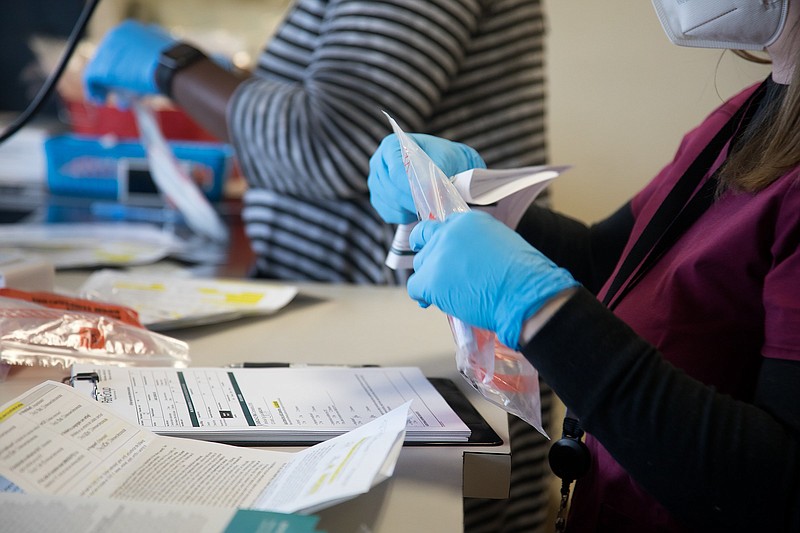Starting in the new year, the Tennessee Department of Health will stop reporting COVID-19 data on a daily basis and move to weekly updates instead at a time when the omicron variant is fueling a record-breaking surge in new cases across the state.
Tennessee Health Commissioner Dr. Lisa Piercey announced the changes during a news briefing on Dec. 22, and department of health spokesperson Bill Christian confirmed in an email Thursday the state will move ahead with its plan.
"Weekly data updates will occur on Wednesdays of each week, and the data will include the previous Sunday-Saturday," Christian said, adding that this time frame coincides with the U.S. Centers for Disease Control and Prevention's Morbidity and Mortality Weekly Report.
Piercey said that the decision to report COVID-19 data weekly instead of daily is a move to incorporate ongoing monitoring of the pandemic with the department's pre-pandemic priorities, such as addressing an all-time high level of drug overdose deaths in the state.
"It's exceedingly clear there's not going to be a date in time where [COVID-19] goes away or where we don't have to worry about this or work on this for quite some time in the future. I know we all have been praying that there is, but it's not in the foreseeable future. So the impetus is on us to make sure we operationalize this, whether that's testing or vaccine, and not have a separate operation for COVID and a separate operation for typical operations. We need to normalize this into our daily routine," Piercey said during the briefing.
Governments, businesses and individuals have all turned to daily COVID-19 data reports throughout the pandemic to make key decisions, such as whether to implement face mask requirements, allow virtual learning in school or limit visitors at health care facilities.
Holden Young, communications manager at the Hamilton County Health Department, said in an email that the local department does not plan to change the frequency of its COVID-19 data reporting at this time.
Asked if the reduced frequency of data reporting will leave state and local policymakers "flying blind" just as a highly contagious new strain of the coronavirus takes hold, Piercey said, "it shouldn't change a single thing that you do."
"Whether cases today are 2,200 or 2,900 - it shouldn't change your day-to-day actions at all," she said about COVID-19 safety measures such as getting vaccinated, isolating when sick and wearing a face coverings.
Another reason the state is scaling back its reporting, she said, is because the case numbers reported are becoming less accurate as a result of the increase in at-home testing. While public health agencies encourage reporting of positive at-home results, people rarely do so.
Even before at-home tests were available, public health officials said case counts should always be viewed as an underestimate since not everyone who's sick gets tested or seeks medical care. Although they are a lagging indicator, hospitalizations are a better metric for gauging the severity of the pandemic, they said. They've also preached to follow trends over day-to-day changes, which can be skewed by the frequency of testing or reporting lags.
"The tests that are reported to us are a smaller and smaller percentage of the overall. So, it really is irrelevant if the number today is 300 or 400 higher than yesterday or lower than yesterday. What we want to look at is trends over time, and weekly reporting allows us to do that, just like we do with flu," Piercey said, noting that daily reporting is "not a sustainable way to do it in perpetuity. We are going to be transitioning into recording data like we report other conditions."
For influenza surveillance, the CDC partners with a network of public health labs and health care providers in each region across the country that agree to report their incidence of cases to form weekly flu reports that estimate the burden of disease. An average health care provider is only required to report pediatric flu deaths in children under 18 and pregnant women and any laboratory tests that reveal a novel influenza strain that differs from the normal seasonal strains.
Some reasons why the CDC states it uses this reporting system are because many people who get the flu never go to the doctor or get tested, and some common flu tests are not highly sensitive, meaning they can misdiagnose the illness. Also, given the historically large volume of flu cases, it would take a vast amount of resources to test and report every case in a typical flu season.
Dr. Marcus Plescia, chief medical officer at the Association of State and Territorial Health Officials, a national nonprofit organization representing public health agencies in the United States, said in a New York Times article Thursday that "our entire approach to the pandemic has been case-based surveillance: We have to count every case, and that's just not accurate anymore. It's just becoming a time where we've got to think about doing things differently."
Tennessee is not the only state to scale back its COVID-19 reporting. Alabama, Florida and Nebraska are among a handful of states that have stopped, suspended or reduced reporting frequency.
Reporting of test positivity rates will also change in Tennessee to no longer include results from rapid antigen tests - the type of tests normally used at home - since that's another metric that's becoming grossly inaccurate with the rise of at-home testing.
The state will continue to calculate test positivity rate using the results of traditional molecular PCR tests, which labs are required to report to the state. Piercey said the PCR positivity rate most likely mirrors the positivity rate of at-home tests.
Contact Elizabeth Fite at efite@timesfreepress.com or follow her on Twitter @ecfite.
